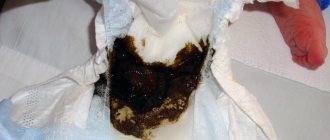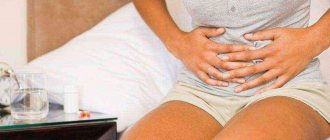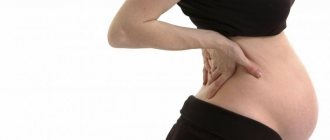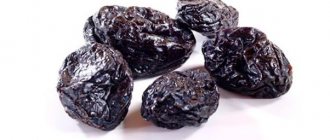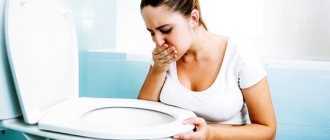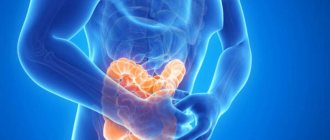Causes of yellow stool
Nutritional Features
Eating large amounts of carrots and sweet potatoes causes stool to change color because these foods contain natural coloring agents. Bright yellow stool appears after eating dishes with turmeric. The symptom is observed when following a dairy diet and a predominance of fermented milk products in the diet. Natural causes only provoke a change in the color of stool; the consistency and frequency of bowel movements remain normal.
Childhood
In newborns, the stool is yellow, which is due to the consumption of breast milk alone. Stools normally have a mushy consistency. After a few months, the color changes to mustard or yellowish-green, which is also a normal variant. In children of the first year of life who are bottle-fed, the stool is light brown or light yellow with a pungent odor.
Intestinal infections
Light-colored stool is detected during infectious processes that affect the small intestine and interfere with normal digestion of food. Escherichiosis is characterized by liquid, golden-yellow stool. The frequency of bowel movements increases to 10-15 times a day. Greenish-yellow stool is produced by the gastrointestinal form of salmonellosis.
Frequent, light yellow stools occur with rotavirus infection. Feces are very liquid, with a specific pungent odor. The disease is usually diagnosed in children of preschool and primary school age who have not yet learned to maintain hygiene. Yellow feces are also provoked by other reasons: enterovirus infection, foodborne toxic infection.
Pancreatic enzyme deficiency
If there is a lack of digestive enzymes in the small intestine, some of the food is not digested, but is excreted from the body in stool, which becomes light or pale yellow in color. In chronic pancreatitis, the symptom is observed periodically: if you follow a special diet, the feces have a normal color; when the gastrointestinal tract is overloaded with fatty foods, it becomes lighter and acquires a mushy consistency.
The yellow coloration of stool is preceded by heaviness and pain in the epigastrium, patients complain of rumbling and flatulence. In acute pancreatitis, the color of stool suddenly changes to light yellow or grayish. At the same time, the person is bothered by severe girdling pain in the upper abdomen and repeated vomiting, which does not bring relief.
Diseases of the hepatobiliary system
The typical brown color of stool is due to bile acids and stercobilin, which enter the intestines with bile. Periodic light yellow stools with a mushy consistency are characteristic of chronic cholecystitis or cholelithiasis in the acute stage, when the secretion of bile is impaired. Similar symptoms are observed in functional disorders of the gallbladder.
Lightening of stool is caused by liver causes: viral or toxic hepatitis of mild to moderate severity, in which the biliary function is partially preserved. The appearance of yellow stool is accompanied by heaviness in the right hypochondrium, constant nausea and loss of appetite. Symptoms worsen after eating fatty foods. With the complete cessation of bile secretion, the yellow color of the stool is replaced by grayish-white.
Giardiasis
Giardia multiplies in the gallbladder, disrupts the flow of bile and helps lighten the stool. The frequency of bowel movements with giardiasis increases to 5-7 times a day, the feces are bright yellow and liquid, with a strong fetid odor. In addition, the person complains of dull pain in the right hypochondrium, flatulence, nausea and vomiting mixed with bile. Normalization of stool color occurs on days 5-7 of the disease.
Celiac disease
Symptoms occur with large consumption of cereals - barley, wheat, rye. Light yellow, pasty stools with a strong unpleasant odor may appear periodically, and then constantly in childhood and adolescence, which is combined with weight loss, stunted growth and physical development. Newly detected yellow stool in an adult indicates a mild form of celiac disease, which can be easily controlled with diet.
Complications of pharmacotherapy
Many medications provoke disturbances in the digestion and absorption of food, which is manifested by yellowing of stool and an increase in the frequency of bowel movements. A person notes seething and rumbling in the intestines, pain throughout the abdomen, and lack of appetite. When taking antibiotics, the stool color is greenish-yellow, which is associated with intestinal dysbiosis. The yellow color of stool is caused by the following medicinal reasons:
- Anti-tuberculosis drugs: isoniazid, ethambutol, streptomycin.
- Estrogen derivatives.
- Cytostatics: methotrexate, cyclophosphamide, adriamycin.
- Some non-steroidal anti-inflammatory drugs: aspirin, paracetamol, diclofenac.
Rare causes
- Viral infections: cytomegalovirus, infectious mononucleosis.
- Hormonal changes in women: premenstrual period, pregnancy, menopause.
- Bilirubin conjugation disorders: Gilbert's syndrome, Crigler-Najjar syndrome.
- Psychological reasons: severe stress, depression.
What should stool look like normally and what do its changes indicate?
Gastrointestinal tract 11/13/2013
Stool or feces is the contents of the lower parts of the large intestine, which is the end product of digestion and is eliminated from the body during bowel movements.
Individual stool characteristics can tell a lot about a person's health and help in making a diagnosis. Below are interpretations of stool quality in normal and pathological conditions.
1. Number of bowel movements. Norm: regularly, 1-2 times a day, but at least 1 time in 24-48 hours, without prolonged strong straining, painless. After defecation, the urge disappears, a feeling of comfort and complete bowel movement occurs. External circumstances can increase or inhibit the frequency of the urge to defecate. This is a change in the usual environment, a forced position in bed, the need to use a bedpan, being in the company of other people, etc. Changes: Lack of bowel movements for several days (constipation) or too frequent bowel movements - up to 5 times or more (diarrhea).
2. Daily amount of feces Normal: With a mixed diet, the daily amount of feces fluctuates within a fairly wide range and averages 150-400 g. Thus, when eating predominantly plant foods, the amount of feces increases, while in animals that are poor in “ballast” substances, it decreases. Changes: Significant increase (more than 600 g) or decrease in the amount of feces. Reasons for increasing the amount of feces (polyfecal):
- Consuming large amounts of plant fiber.
- Increased intestinal peristalsis, in which food is poorly absorbed due to its too rapid movement through the intestinal tract.
- Disruption of digestive processes (digestion or absorption of food and water) in the small intestine (malabsorption, enteritis).
- Decreased exocrine function of the pancreas in chronic pancreatitis (insufficient digestion of fats and proteins).
- Insufficient amount of bile entering the intestines (cholecystitis, cholelithiasis).
Reasons for reducing the amount of feces:
- Constipation, in which due to prolonged retention of feces in the large intestine and maximum absorption of water, the volume of feces decreases.
- Reducing the amount of food eaten or predominantly digestible foods in the diet.
3. Passing feces and floating in water. Normal: feces should be released easily, and in water it should sink gently to the bottom. Changes:
- If there is insufficient amount of dietary fiber in food (less than 30 grams per day), feces are released quickly and splash into the water of the toilet.
- If the stool floats, this indicates that it has an increased amount of gas or contains too much undigested fat (malabsorption). Also, stool may float if you eat a lot of fiber.
- If the stool is difficult to wash off with cold water from the walls of the toilet, it means it contains a large amount of undigested fat, which happens with pancreatitis.
4. Stool color Normal: With a mixed diet, the stool is brown. Breastfed babies have golden-yellow or yellow stools. Change in stool color:
- Dark brown - with a meat diet, constipation, impaired digestion in the stomach, colitis, putrefactive dyspepsia.
- Light brown - with a dairy-vegetable diet, increased intestinal motility.
- Light yellow - indicates too rapid passage of feces through the intestines, which do not have time to change color (diarrhea) or impaired bile secretion (cholecystitis).
- Reddish - when eating beets, when bleeding from the lower intestines, for example. for hemorrhoids, anal fissures, ulcerative colitis.
- Orange – when consuming the vitamin beta-carotene, as well as foods high in beta-carotene (carrots, pumpkin, etc.).
- Green - with a large amount of spinach, lettuce, sorrel in food, with dysbacteriosis, increased intestinal motility.
- Tarry or black - when eating currants, blueberries, as well as bismuth preparations (Vikalin, Vikair, De-Nol); with bleeding from the upper gastrointestinal tract (peptic ulcer, cirrhosis, colon cancer), with ingestion of blood during nosebleeds or pulmonary bleeding.
- Greenish-black - when taking iron supplements.
- Grayish-white stool means that bile is not entering the intestines (bile duct blockage, acute pancreatitis, hepatitis, cirrhosis of the liver).
5. Consistency (density) of feces. Normal: shaped and soft. Normally, stool consists of 70% water, 30% from the remains of processed food, dead bacteria and desquamated intestinal cells. Pathology: mushy, dense, liquid, semi-liquid, putty-like. Change in stool consistency.
- Very dense feces (sheep) - for constipation, spasms and stenosis of the colon.
- Mushy feces - with increased intestinal motility, increased secretion in the intestines during inflammation.
- Ointment-like - for diseases of the pancreas (chronic pancreatitis), a sharp decrease in the flow of bile into the intestines (cholelithiasis, cholecystitis).
- Clay or putty-like feces are gray in color - with a significant amount of undigested fat, which is observed when there is difficulty in the outflow of bile from the liver and gallbladder (hepatitis, blockage of the bile duct).
- Liquid – in case of impaired digestion of food in the small intestine, impaired absorption and accelerated passage of feces.
- Foamy - with fermentative dyspepsia, when fermentation processes in the intestines prevail over all others.
- Loose stools like pea puree - with typhoid fever.
- Liquid, colorless stools like rice water - with cholera.
- When the stool has a liquid consistency and frequent bowel movements, one speaks of diarrhea.
- Liquid-mushy or watery stools can occur with high water consumption.
- Yeasty stool - indicates the presence of yeast and may have the following characteristics: curdled, foamy stools like rising sourdough, may have strings like melted cheese, or have a yeasty odor.
6. Shape of feces. Standard: cylindrical, sausage-shaped. The stool should come out continuously, like toothpaste, and be about the length of a banana. Changes: ribbon-shaped or in the form of dense balls (sheep feces) is observed with insufficient daily water intake, as well as spasms or narrowing of the large intestine.
7. The smell of feces. Normal: fecal, unpleasant, but not harsh. It is due to the presence of substances in it that are formed as a result of bacterial breakdown of proteins and volatile fatty acids. Depends on the composition of the food and the severity of the processes of fermentation and decay. Meat foods give off a pungent odor, while dairy foods give off a sour odor. If digestion is poor, undigested food simply rots in the intestines or becomes food for pathogenic bacteria. Some bacteria produce hydrogen sulfide, which has a characteristic rotten odor.
Changes in stool odor.
- Sour – for fermentative dyspepsia, which occurs with excessive consumption of carbohydrates (sugar, flour products, fruits, peas, etc.) and fermented drinks, such as kvass.
- Fetid - with impaired pancreatic function (pancreatitis), decreased flow of bile into the intestines (cholecystitis), hypersecretion of the large intestine. Very foul-smelling stool may be due to bacterial overgrowth
- Putrefactive – in case of indigestion in the stomach, putrefactive dyspepsia associated with excessive consumption of protein products that are slowly digested in the intestines, colitis, constipation.
- The smell of rancid oil is due to bacterial decomposition of fats in the intestines.
- Faint odor - with constipation or accelerated evacuation from the small intestine.
8. Intestinal gases. Normal: Gases are a natural by-product of the digestion and fermentation of food as it moves through the gastrointestinal tract. During and outside of bowel movements, 0.2-0.5 liters of gas are removed from the intestines of an adult per day. The formation of gas in the intestines occurs as a result of the vital activity of microorganisms inhabiting the intestines. They decompose various nutrients, releasing methane, hydrogen sulfide, hydrogen, and carbon dioxide. The more undigested food enters the colon, the more active the bacteria are and the more gases are produced.
An increase in the amount of gases is normal.
- when eating large amounts of carbohydrates (sugar, baked goods);
- when eating foods that contain a lot of fiber (cabbage, apples, legumes, etc.);
- when consuming foods that stimulate fermentation processes (brown bread, kvass, beer);
- when consuming dairy products if you are lactose intolerant;
- when swallowing large amounts of air while eating and drinking;
- when drinking large amounts of carbonated drinks
An increase in the amount of gases in pathology.
- Enzyme deficiency of the pancreas, in which food digestion is impaired (chronic pancreatitis).
- Intestinal dysbiosis.
- Irritable bowel syndrome.
- Gastritis, peptic ulcer of the stomach and duodenum.
- Chronic liver diseases: cholecystitis, hepatitis, cirrhosis.
- Chronic intestinal diseases – enteritis, colitis
- Malabsorption.
- Celiac disease.
Difficulty in passing gases.
- intestinal obstruction;
- intestinal atony with peritonitis;
- some acute inflammatory processes in the intestines.
9. Stool acidity. Normal: with a mixed diet, acidity is 6.8–7.6 pH and is due to the vital activity of the colon microflora. Changes in stool acidity:
- sharply acidic (pH less than 5.5) – with fermentative dyspepsia.
- acidic (pH 5.5 - 6.7) - if the absorption of fatty acids in the small intestine is impaired.
- alkaline (pH 8.0 - 8.5) - with rotting of undigested food proteins and activation of putrefactive microflora with the formation of ammonia and other alkaline substances in the colon, with impaired pancreatic secretion, colitis.
- sharply alkaline (pH more than 8.5) - for putrefactive dyspepsia.
Normally, feces should not contain blood, mucus, pus, or undigested food residues.
medinteres.ru
Diagnostics
If the color of stool changes to yellow, you should consult a gastroenterologist. To determine the cause of yellowing of stool, an instrumental examination of the digestive system is performed. To clarify the diagnosis and identify hidden metabolic disorders, highly specific laboratory methods are prescribed. In diagnostic terms, the most informative are:
- Coprogram. Macroscopically study the consistency, color and smell of stool. During microscopic analysis, attention is paid to the presence of undigested muscle fibers and starch grains, the number of erythrocytes and leukocytes. Be sure to examine the stool for helminth eggs, and to assess the functioning of the pancreas, fecal elastase is determined.
- Sonography. A survey ultrasound of the abdominal cavity reveals inflammatory or fibrotic changes in the liver and pancreas, signs of intestinal damage. To clarify the cause of the disease, elastometry is informative, allowing you to quickly and painlessly determine the degree of liver fibrosis.
- X-ray imaging. To study the motor function of the intestine and detect local inflammatory processes, radiography of the abdominal cavity with a barium mixture is recommended. A plain X-ray of the abdomen helps visualize space-occupying lesions, liver or pancreatic cysts. If necessary, irrigoscopy is performed.
- Retrograde cholecystopancreatography. Endoscopic examination of the bile and pancreatic ducts is an invasive examination that is used to diagnose cholangitis, cholelithiasis, and reactive pancreatitis. The method is therapeutic and diagnostic, since during ERCP it is possible to remove small stones that block the bile ducts.
- Blood tests. A blood test for the level of pancreatic lipase and amylase is aimed at studying the enzymatic activity of the pancreas. Liver tests are also studied. Serological reactions (ELISA, RIF) detect specific antibodies when viral or bacterial intestinal infections are suspected.
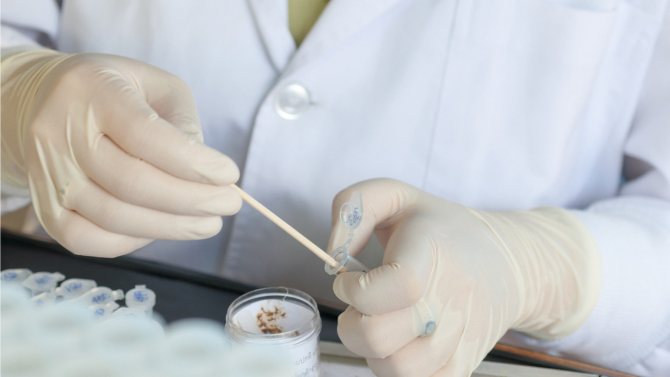
Treatment
Help before diagnosis
The yellow color of stool, caused by eating habits and observed against the background of normal health, disappears on its own after 2-3 days. In order not to overload the intestines during this period, it is advised to avoid fatty and fried foods and alcohol. If a change in stool color occurs against the background of diarrhea or abdominal pain, you should visit a specialist. To improve your condition, you can drink sorbents. The use of antidiarrheal drugs is undesirable.
Conservative therapy
The yellowish color of stool is caused by various reasons, so the list of therapeutic measures is selected individually. An important stage of treatment is following a special diet, the basis of which is stewed vegetables, lean meat and fish, cereals and soups. In case of chronic pathologies of the pancreas and liver, such a diet must be followed constantly. To treat diseases in which the stool is yellow, the following medications are prescribed:
- Sorbents. Activated carbon preparations, smecta, are designed to bind and remove toxins from the intestines. Medicines speed up recovery from toxic infections, help cope with diarrhea, and improve digestive functions.
- Probiotics. For dysbiosis, bacterial overgrowth syndrome and side effects of pharmacotherapy, beneficial bacteria are taken that populate the large intestine and promote digestion. For a lasting effect, they are used in courses of at least 10 days.
- Enzyme agents. When the exocrine function of the pancreas is suppressed, drugs containing pancreatic enzymes are used. They eliminate the causes of yellow stools and stimulate the processes of cavity digestion in the small intestine.
- Choleretic drugs. Indicated for hepatobiliary pathology. They improve the chemical composition of bile and ensure its flow into the duodenum, which is required for the breakdown of fats. The color of stool returns to normal within a couple of days after the start of treatment.
- Rehydration therapy products. All intestinal infections are accompanied by large fluid losses, to replenish which there are oral solutions. They contain the optimal amount of salts and glucose, restore acid-base balance and electrolyte composition.
How to treat rotavirus in a child?
Rotavirus infection has similar symptoms to many diseases; you should not diagnose it yourself. Rotavirus in a child should be treated comprehensively; measures are aimed at combating the manifesting symptoms of the disease. Rotavirus is an intestinal infection caused by Rotavirus. People of any age get sick, but the infection most often affects six-month-old to two-year-old children. The source of infection can be a person sick with rotavirus, as well as a healthy virus carrier. Children become infected from their parents and from other children in the group. The virus multiplies on the mucous membrane of the stomach and intestines. Excretion in feces begins simultaneously with the appearance of the first symptoms.
Infection occurs through the fecal-oral route, which is why the infection is also called “unwashed hands disease.” The virus is often transmitted through unwashed food and raw water. Transmission occurs through household items.
Main symptoms of rotavirus infection
1. Intestinal syndrome: vomiting, discomfort in the abdominal area, even cramping pain, diarrhea, yellow clay-like stool with a sharp sour odor.
2. Respiratory syndrome: runny nose, sore throat, sore throat, red conjunctiva of the eye. Symptoms resemble flu or cold.
3. Consequences of intoxication of the body: lack of appetite, general weakness, increased fatigue, fever, headache.
The incubation period is 1 - 5 days. At this time, a sick person is most dangerous in terms of infectiousness; the concentration of the virus in feces is maximum.
Treatment of rotavirus in children
There is no special treatment for rotavirus infection; measures are limited to combating the symptoms of the virus.
The doctor will prescribe medications and recommend treatment. Reduce temperature with paracetamol and ibuprofen. For vomiting - in the form of suppositories. The dosage is determined by the doctor. Do not wrap your baby up; cover your sleeping baby with a light diaper instead of a blanket.
Smecta is usually used to treat diarrhea. To prevent intestinal bacterial infections, Enterol is prescribed. It is not recommended to give medicine for severe abdominal pain; in this case, calling an ambulance is mandatory. It is possible to prescribe enzymes for better digestion of food. Check with your doctor before using any medicine for your child. The main danger of rotavirus infection is the risk of dehydration. Before the doctor arrives, give your child Regidron solution - this will restore the water-salt balance. One sachet is dissolved in a liter of boiled water, taken in small sips of 50 ml every hour to avoid vomiting.
Nutrition and regimen
The food taken by the child must be natural. The content of surrogates and preservatives prevents the body from producing full antibodies to fight the virus. In the first days of illness, the diet includes: chicken broth, jelly, rice cooked in water. Dairy products should not be consumed. If vomiting, do not force your child to eat. The patient becomes drowsy; provide him with bed rest and rest. Let him sleep as much as his body requires.
Prevention of rotavirus
By following certain rules developed by virologists, the risk of rotavirus infection is reduced.
Provide a balanced diet, watch excess weight. Encourage your child to lead an active lifestyle and maintain a daily routine together. The coherence of the body’s work, the ability to get rid of viruses, toxins and cope with the stress of illness directly depend on this. Strengthen the habit of washing your hands frequently and maintaining hygiene. Wash or scald vegetables and fruits with boiling water before eating. You should drink boiled or specially purified water. The editors of uznayvse.ru wish you and your children health.
www.uznayvse.ru
What makes a good poop joke appealing?
The main reason why children find inappropriate jokes especially funny is very simple: they piss off their parents.
"Children first learn that words have meaning, and then they learn that some words have special power," says Lawrence Cohen, Ph.D. and author of Games That Learn. Body functions, Cohen says, are of particular interest to children, which extends to words related to them. Going to the toilet comes with an unusual sensory experience coupled with privacy and secrecy that children become aware of through parental reactions to talking about it.
“Children are always experimenting with their power, and the ability to make an adult laugh or feel awkward means a lot to a child,” Cohen comments.
But that's not all: toilet humor can also be a powerful tool.
People often use humor as a means of coping with anxiety. Babies who are afraid of being separated from their parents laugh at the game of peek-a-boo. Older children may joke about more difficult things that make them uncomfortable, such as sex or death. But for children from three to, say, six years old, toilet incidents are always on the list of their most exciting events.
“I think adults take for granted their ability to get to the bathroom on time, while children don’t,” says Laura Markham, author of Parenting Without Whining, Punishing, or Yelling: How to Keep Your Children Obedient. Even if they are already potty trained, they can still pee and are afraid of it.
Humor allows children to take control of their fears.
“If you can make a joke in a stressful situation, it can go a long way toward defusing the situation,” says Doris Bergen, PhD, a professor of educational psychology at the University of Miami who has spent much of her career studying children's play and humor development. “It’s also socially acceptable.”
This is a universal method of compensation: comedians joke about what bothers them. They get ahead of discomfort and tightness, seizing control of it before they can do the same.
Children do the same, although they don't realize it.

Possible reasons
The reasons why a child plays with, eats or smears feces depend on his age and developmental characteristics.
Age interest. Until about two years of age, it is normal for children to become interested in their own excrement. Children learn the functions of their body and waste products. At the same time, the parents' reaction to the child's interest can reinforce this behavior for a long time.
Method of manipulation. Smearing feces can be a way to avoid something or get what you want: to cause a certain emotional reaction, to draw attention to yourself, to get away from an unpleasant situation or demands. Also, children who have communication problems may use these situations as a way to communicate. They quickly learn which behaviors lead to the most interaction.
Sensory features. Stool smearing may be resorted to by babies who like strong smells and “dirty” games, and at the same time they have no other way to satisfy their needs. Playing with sticky and soft materials such as glue, shaving foam, play dough, and sand can reduce the need to smear stool. Strongly smelling substances - aroma oil, spices, cheese - will help satisfy your craving for smells.
Psychological and mental problems. Problems with smearing feces can occur in children suffering from OCD (obsessive-compulsive disorder), bipolar disorder, and schizophrenia. This behavior may also occur in children with autism, anxiety, children who have been sexually abused, or children experiencing post-traumatic stress disorder. Donna Williams, an author with autism, points out that poop play has many purposes that can go unaddressed:
- this activity gives a feeling of control over the body and environment, while other areas of life are uncontrollable
- makes you feel in control of your own actions
- promotes expression of anger, frustration, helplessness
- prevents unwanted social contacts
- may be associated with another emotionally calming process
- may be part of an obsessive disorder that is out of control
In any of these cases, you need to pay attention to the child's quality of life and make sure that he has the opportunity and an acceptable way to meet his needs (including emotional and sensory). In severe cases of mental illness, medical attention may be necessary.
Medical cases. Consulting a doctor will rule out possible diseases:
- protozoal infections causing rectal itching
- parorexia or pica - the desire to eat inedible things, can be caused by a deficiency of certain substances in the body
- constipation and problems with bowel movements, which may lead to a desire to explore the anus
- hemorrhoids caused by difficulty having bowel movements
- rectal prolapse - prolapse of the rectum associated with decreased muscle tone of the pelvic floor. Symptoms include encopresis (fecal incontinence), a sensation of incomplete evacuation that leads to exploration of the anus and smearing of feces.
All of these conditions can be treated.
What should parents be wary of?
If a child is voiding colorless masses, parents should look for additional abnormalities:
- temperature;
- child weight loss;
- lack of appetite;
- severe bloating;
- changed color of urine;
- baby's complaints of abdominal pain;
- yellowing of the skin and eye sclera.
The combination of colorless feces with any of the listed conditions indicates the need to call an ambulance. Serious diseases such as pancreatitis, hepatitis, and biliary dyskinesia occur with such disorders.
Signs of pathological processes
In almost 80% of all cases, the reason for the lightening of the child’s stool is a change in diet or its incorrect preparation. This type of feces lasts for several days, after which it regains its normal color. The remaining 10% of children have a burdened clinical history, some complications from the functioning of internal organs or systems. Here they pay attention to all the nuances of changes not only in the child’s condition, but also in his bowel movements. If, against the background of light-colored stool, the child experiences obvious suffering, and the following symptoms are added to everything, then this requires immediate clarification and correction:
- cloudiness and darkening of urine (dark urine with light stool indicates viral hepatitis);
- stool liquefaction, diarrhea (the number of urges tends to be 10 or more);
- intense abdominal pain;
- high temperature, not brought down by anti-heat agents;
- malaise, muscle weakness;
- strong feeling of thirst;
- emotional instability (mobility along with indifference).
All these signs are not normal. You should consult a doctor or call an ambulance. Emergency assistance is especially needed for vomiting and diarrhea in young children. Children have a very difficult time dealing with dehydration. It is enough to lose only 25% of the total norm and restoration of the water-salt balance must already be done in intensive care conditions. To compare the diagnosis to find out why the child has light-colored stools, you need to take into account many different factors. The high mortality rate of children under 3 years of age from intestinal disorders is due precisely to complications of intoxication (dehydration, septic shock, vomiting and diarrhea).
When to sound the alarm
Parents should know that diseases that manifest themselves in an acute form have a rapidly developing clinical picture.
In such cases, light-colored stool is accompanied by the following serious symptoms:
- Nausea.
- Vomit.
- A sharp increase in body temperature above 38 degrees.
- Dizziness.
- Headache.
- Acute thirst.
- Decreased appetite.
- Yellowing of the skin and whites of the eyes.
Also, these symptoms are in most cases accompanied by foamy feces, which is a signal for urgent alarm. This clinical picture indicates the development of a serious illness that is actively developing and affecting internal organs. Often a child with such ailments feels very weak and gets tired quickly.
Parents must immediately respond to these symptoms, among which the child’s white feces are only the tip of the iceberg, and the essence of the problem is much more serious, and at this time very serious disorders occur in the body.
Important! It is prohibited to select treatment methods on your own. You can cause significantly more harm to the body with unqualified help and aggravate the patient’s condition. Even the most serious illness can be quite successfully cured with timely treatment, so do not be afraid to call a doctor.
If, after an initial examination by a pediatrician, the cause of the appearance of white feces cannot be determined, the child is referred for consultation to a gastroenterologist, immunologist, endocrinologist or infectious disease specialist. The course of treatment is selected individually, in accordance with the diagnosis:
- If white feces are the result of pancreatitis, treatment in children is carried out in a hospital. Therapy is aimed at ensuring rest, preventing chemical or mechanical damage to the pancreas, relieving symptoms, and eliminating the cause of the disease. The patient is prescribed a food break for 1-3 days. During this period, the stomach contents are suctioned out to prevent enzyme activation. After pain has subsided, nutrition is gradually introduced. The diet should consist of boiled or steamed food. Salting dishes is prohibited. The patient needs 5-6 meals a day, and it should be warm, liquid or semi-liquid. It is recommended to expand the menu after a month. In parallel with the diet, drug treatment is carried out.
- The appearance of white stool during bowel movements can occur due to dysbacteriosis. Treatment involves complex therapy, which includes medications and diet. The baby's diet should be enriched with products containing bifidobacteria and lactobacilli. In this case, milk should be excluded completely. The doctor may recommend the use of yoghurt, kefir, and cottage cheese. It is beneficial for children to eat vegetables, fruits and cereals made from oatmeal, buckwheat, rice and millet, which contain important microelements. To provide the body with proteins, you need to include dietary varieties of meat and fish, steamed or boiled, in your diet. Infants who are on artificial feeding need to be given special medicinal mixtures.
- If white feces appear due to hepatitis, treatment is carried out in a hospital. It includes symptomatic therapy, detoxification, vitamin intake, maintenance and restoration of the liver. During treatment, children are isolated according to the type of virus.
- Whipple's disease requires complex treatment, consisting of diet, medications and vitamin-mineral complexes. Therapy for pathology can take a long time (at least 1 year). Doctors recommend following diet No. 5. The diet should be light and high in protein. It is required to significantly reduce the consumption of foods containing fats.
- Antibiotics are not used to treat rotavirus infection, since there is no suitable drug to combat this pathogen. Symptomatic therapy and diet are used to improve the baby’s condition. It is recommended to exclude milk, spices, fresh vegetables and fruits, fats, and carbonated drinks from the diet of children suffering from the disease. The patient should be fed semi-liquid porridge, jelly, and fermented milk products. It is necessary to prevent dehydration of the body. To do this, give a weak solution of Regidron after each vomiting.
Yellow loose stool in a 3 year old child
A change in the nature of a child's stool always worries parents. But it is extremely difficult to help a child without knowing the true cause of the symptom. Essentially, diarrhea is a defensive reaction to an irritant.
When pathogenic microflora enters parts of the digestive system, the body tries to get rid of it on its own. And classic folk recipes for holding stool together can only worsen the baby’s condition.
Let's try to figure out what can cause yellow diarrhea in a child and what measures parents should take.
When you shouldn't worry
Normally, a light yellow color of stool is observed in infants. This can be explained by the fact that the nutrition of children at this age is based on the consumption of large amounts of milk (mother's or cow's). And since food is consumed in liquid form, the stool has a mushy consistency, which is easily confused with diarrhea. Moreover, the younger the baby, the thinner his stool.
Another reason is the imperfection of the digestive system.
At one year of age, the pancreas does not secrete enough enzymes to digest food, and the liver does not produce the amount of bile necessary to color stool brown. So, in the absence of other symptoms of intestinal infection or other pathologies, loose and pale stools are normal.
To dispel all doubts, you can consult with your local pediatrician.
Dangerous causes of light diarrhea
In medical practice, there are four main causes of pale or bright yellow diarrhea:
- Intestinal infections. With this pathology, yellow diarrhea in a child is often accompanied by vomiting, abdominal pain and increased body temperature. In some cases, blood or mucous contents may be found in the stool.
- Rotavirus infection. The main difference between this condition and intestinal infections is the absence of pain and a persistent increase in temperature that cannot be normalized with antipyretic drugs. Yellow diarrhea in a child, characteristic of the acute onset of the disease, is replaced by watery gray stools. Excessive bowel movements can cause dehydration in a small body.
- Food allergies. The most common allergens are chocolate, strawberries, oranges, eggs and cow's milk. In addition to being highly allergenic, these products have a laxative effect. And the active substances contained in their composition irritate the intestinal mucosa, causing their accelerated excretion along with feces.
- Whipple's disease. This is a dangerous disease characterized by long periods of light yellow diarrhea with an increase in body temperature in the initial stage of the disease. To date, the main cause of the pathology is unknown. It is assumed that the disease is based on a violation of fat metabolism, but this is by no means the only reason for the spread of infection. In the absence of serious inpatient treatment, the disease leads to dehydration, weight loss, damage to cells of the nervous system, loss of vision, and disruption of the heart and other organs.
Whipple's disease primarily affects men between 40 and 50 years of age. But its manifestation in patients of other age categories cannot be excluded. Thus, in medical practice, repeated episodes of diseases in children aged three years and older are known.
Key Recommendations: Action Plan for Parents
Do not panic. Light diarrhea in a child does not always indicate any pathology. And even if this is so, then your lamentations will do little to help the baby. We need to act.
The first thing you need to do is assess the situation. Your task is to help the child, and not to become hysterical about supposed diagnoses. First you need to measure the baby's temperature. If it rises to 38 0 or higher, call a doctor.
If the baby refuses food and water, and diarrhea is accompanied by vomiting, do not wait for the local pediatrician, but immediately call an ambulance.
If these symptoms persist for a long time, the child may become dehydrated, which will lead to the development of serious complications.
If a child has yellow diarrhea without fever, the color of the urine has not changed, and in general the baby feels well, most likely the reason for the changes in the character of the stool lies in the diet. So carefully study your diet by reviewing the dishes on the menu and how they are prepared.
Correcting a child's diet allows the color of stool to normalize within two days. During this period, you need to carefully monitor the condition of the baby in order to detect any changes in his behavior and health in time.
Feeding a child with loose yellow stools
For any disease, it is necessary to follow a gentle diet. And even more so with indigestion. If no infection is detected, and after a doctor’s examination you have been diagnosed with a food allergy or indigestibility of any foods, reconsider the young patient’s diet.
- Light-colored feces in infants are a consequence of the high fat content in the diet. For nursing mothers, all fatty foods and possible allergens for the baby should be excluded from the diet.
- After this, to normalize stool, increase the number of feedings, reducing the duration of each of them. According to modern standards, it is recommended to breastfeed infants on demand, so adhere to these standards. Dehydration is of no use to you now.
- Maintain drinking regime. If a child has yellow diarrhea, regardless of the cause and age, water is vital to normalize the condition. Lack of fluid in the body can lead to irreversible consequences.
- For older children, it is necessary to reduce the portion size, maintaining the total calorie content and nutritional value of the daily diet, dividing it into five to six meals. With a smaller volume, food will be easier to absorb by the body.
- All dishes must be cooked by boiling or steaming. They should be served crushed, preferably passed through a blender to facilitate the digestion process.
- The food temperature should be comfortable for the body. Hot or cold food is poorly processed by the body and will take longer to digest.
- During diarrhea and the recovery period, completely exclude fresh vegetables and fruits, fried and fatty foods, and milk from the children's diet. Reintroduce it into the diet gradually and in small quantities.
To avoid possible recurrence of episodes of diarrhea, remember to eat healthy for your child at any age.
Medications
It is better not to get carried away with drug therapy at your own discretion, even for an adult. And even more so when it comes to the health of the child.
Therefore, before purchasing medications, be sure to consult your pediatrician. Not all modern developments of pharmaceutical companies are approved for use in childhood.
And he will help you choose the most effective and at the same time gentle means, eliminating possible contraindications and risks.
Source: https://super-parents.ru/info/zheltyj-zhidkij-stul-u-rebenka-3-goda/
Drug therapy
If white feces appear in a child due to pathological processes, the basis of treatment is medications. They are prescribed based on the patient’s diagnosis:
- For pancreatitis, the child is prescribed enzyme preparations (Mezim, Pancreatin, Creon). In addition, drug treatment includes the following medications: analgesics, antispasmodics (No-shpa, Analgin, Papaverine), solutions based on glucose, salts, proteolytic enzyme blockers (intravenously), antisecretory drugs (Famotidine, Octreotide), drugs to improve microcirculation (Trental , Pentoxifylline, Dipyridamole), antibiotics (necessary for purulent, bacterial processes).
- Dysbacteriosis is treated in 2 stages. First you need to get rid of pathogenic microflora. For this purpose, antibacterial drugs and bacteriophages are prescribed. At the second stage, replacement therapy is used, which involves taking probiotics and prebiotics. Often, Acipol, Linex, Bifiform, Enterol, Lactobacterin are used to restore microflora in children with white stool.
- Drug therapy for hepatitis consists of a set of measures: to reduce intoxication, it is necessary to administer a glucose solution, take activated charcoal, Enterosgel, Sorbex; to restore liver health, hepatoprotectors are used - Essentiale, Karsil, Glutargin, Silibor; choleretic drugs are indicated - Cholenzym, Chofitol; immunomodulators are needed - Immunal, Dekaris, Taktivin; antiviral medications are prescribed - Interferon, Viferon, Laferobion; A small patient requires complex vitamin preparations.
- Drug therapy is the mainstay of treatment for Whipple's disease. The following groups of drugs are used: antibacterial (Cotrimoxazole); antibiotics - preference is given to tetracyclines, but penicillin drugs may be prescribed; complexes containing vitamins and minerals; hormonal medications - prescribed at the discretion of the doctor.
- If a small patient has a rotavirus infection, he is prescribed medications that reduce the manifestations of the disease. The following groups of drugs are used: detoxification (Rehydron solution, Smecta, Enterosgel, activated carbon); antipyretics (Nurofen, Panadol, Cefekon); antispasmodics (No-shpa); probiotics, prebiotics (Linex, Acipol).
Light-colored stool and disease
Attentive parents always notice the slightest deviations from the norm, any changes from the usual way of life. Unfortunately, more and more children are born with congenital developmental pathologies or have hereditary factors that determine their future health. It is the perinatal development of the child that largely determines the clinical history of the little patient in the future. In some cases, lightening of the stool can signal serious diseases of the child’s internal organs or systems.
Possible pathologies
The main possible ailments include the following:
- Development of dysbacteriosis. In addition to lightening, greenish streaks are present in the stool. With advanced dysbacteriosis, the stool foams and has a foul odor. The child often suffers from colic, and sometimes the stomach can feel very tense to the touch. A rash resembling hives may appear. The rash is localized on the child's stomach, butt or face.
- Hepatitis A, B, C. Hepatitis is a serious disease that affects liver tissue and leads to serious complications, including the development of liver failure. A characteristic feature of hepatitis is a combination of light-colored stools and very dark urine. Even a doctor cannot diagnose hepatitis on his own, only on the basis of laboratory and instrumental studies.
- Pancreatitis or inflammation of the pancreas. The disease is mainly registered in adult patients, but sometimes occurs in children. Light-colored feces are accompanied by frequent vomiting, nausea, pain in the abdominal area of unknown localization, and high fever.
- Bend of the gallbladder. The bend is often an anatomical feature, an anomaly of formation. Over time, the child gets used to this form of the gallbladder; the condition does not cause any particular problems. Only systemic monitoring of a small patient is recommended. Clarification of stool here consists in the difficulty of separating the entire volume of coloring pigment, bile.
- Diseases of the gastrointestinal tract. The cause of the pathology, especially in newborns, can be congenital malformations of the epigastric organs, anomalies in the structure and size of the organs. Pathologies can also develop as the child grows under the influence of various endogenous or exogenous factors.
- Rotavirus infection. Rotaviruses are accompanied by a clear clinical picture with deterioration of health, increased body temperature, diarrhea and other signs. The first day after infection, the stool in children has a yellowish pale tint, but in subsequent days the stool will clearly resemble white clay.
- Whipple syndrome. A rare disease, often of an autoimmune nature. The pathology is characterized by enlarged lymph nodes and the development of persistent iron deficiency anemia. The number of acts of defecation per day can reach 8-10 times, while the consistency of the stool will be formed. The smell of feces is unpleasant, the color has a grayish tint. A child has light-colored stools, like clay, that occur precisely with this disease.
Article on the topic: Diet 4a for chronic colitis: basic rules, indications and weekly diet for children and adults
Other symptoms that characterize abnormal abnormalities should be considered. Thus, the appearance of blood impurities in a child’s stool may indicate both Whipple’s syndrome and advanced dysbacteriosis. Internal hidden bleeding is possible. Here you should take a stool test for occult blood. Sometimes the child’s condition, even with pathologically altered stools, may not suffer. Of course, this does not apply to rotavirus infection.
Important! Light, almost white feces in children can also appear against the background of a burdened allergy history. Thus, with the allergic nature of changes in stool color, corrective therapy for the contributing condition is required. Timely therapy allows you to get rid of disturbing stools in 3-4 days. Only the attentiveness of parents and adequate participation of doctors will help the child overcome all possible illnesses.
Hepatitis
Light-colored stool may appear due to hepatitis. But this disease is accompanied by other factors. The child becomes lethargic, loses appetite and begins to feel sick. But the first symptom is darkening of the urine. Then the stool begins to lighten. At first the stool will be light yellow, and then completely turn white. At the same time, it will also acquire a grayish tint.
Children under one year of age rarely develop hepatitis B. Especially if the baby has become a carrier of a viral infection. This type of hepatitis has a latent period. The disease can develop slowly, up to six months. First, the child's urine darkens and the stool becomes lighter. Next, appetite disappears and sleep is disturbed. Then vomiting appears and the temperature rises.
Light-colored stool in a child (2 years old) may be a sign of hepatitis A. In this case, the baby’s skin does not immediately turn yellow. First the urine darkens, then the feces turn white. All other signs of the disease are the same as for viral hepatitis B.
Normal consistency of baby stool
Ideal baby stool has a mushy consistency and a light brown color. It should not be completely absorbed into the diaper.
Note! The stool becomes more formed with the start of complementary feeding. Depending on the foods consumed, its shade changes, and pieces of food may appear.
Newborns produce meconium, which is always sticky and thick, reminiscent of motor oil. Even its color is black, it shouldn’t be scary. It appears almost immediately after the baby is born and consists of mucus, water, hair, everything that was digested during intrauterine life. Then the newborn's stool changes, reacting to the mother's milk or formula, and becomes more mushy.
How to prevent white stool in a child
To prevent your baby from having white stools, preventative measures are necessary. A number of simple recommendations should be followed:
- If there are no contraindications, carry out timely vaccination.
- It is necessary to observe the rules of personal hygiene for the baby (wash hands thoroughly, eat only clean foods, meat and other food that may contain parasite eggs must be thoroughly processed).
- Children's daily diet should include fruits, vegetables, grains, dairy products, and plenty of water.
- Ensure your baby has good physical activity through walks, games, and sports.
What to do if your child has light-colored poop?
If your child has white stools like clay, then do not panic. Especially if, in general, the baby feels very satisfactory, is not capricious and retains his appetite. In this case, it is necessary to exclude from his diet all foods that have bright pigmentation and theoretically can affect the color of feces (apricots, carrots, red apples, cottage cheese, hard cheese, sour cream, radishes). It is enough to wait 1-2 days and at the same time constantly monitor whether the color of the stool changes.
If there is no expected reaction and the baby continues to have colorless stool, you should immediately consult a pediatrician. It makes no sense to give any medications or dietary supplements on your own, since before starting treatment it is necessary to establish the true cause of the atypical behavior of the digestive system. This is only possible in the inpatient department of the clinic.
Prevention
The main recommendation of doctors for the prevention of diseases of the gastrointestinal tract is careful attention to the baby’s diet and the choice of foods consumed. The baby should receive a variety of foods every day, rich in beneficial microelements, vitamins and minerals. A nutritious diet will contribute to excellent bowel function and, as a result, regular and normal bowel movements.
If you want to see your baby always healthy and full of energy, include the following products in his daily diet:
- vegetables and fruits;
- dairy products;
- cereals;
- a large amount of water.
Make sure your child moves a lot and plays active games. Make sports a family activity; it will encourage and excite your child and help him fall in love with sports and active pastimes.
A healthy lifestyle, established since childhood, will help maintain excellent body functioning in adulthood, and useful nutrition skills will be useful for maintaining excellent physical shape. Eat right and be healthy!
White feces in a child is a sign that often worries parents, regardless of whether the child is 1 year old, 2 years old, or 6 years old. The color of stool can say a lot about the health of a child of any age.


